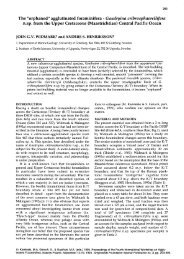Full Text | Download - Grzybowski Foundation - The ...
Full Text | Download - Grzybowski Foundation - The ...
Full Text | Download - Grzybowski Foundation - The ...
You also want an ePaper? Increase the reach of your titles
YUMPU automatically turns print PDFs into web optimized ePapers that Google loves.
Alegret, Ortiz & Kaminski (eds.), 2012. Ninth International Workshop on Agglutinated Foraminifera, Abstract Volume<br />
<strong>The</strong> record of Toarcian Oceanic Anoxic Event by agglutinated foraminiferal<br />
morphogroups from Northern Siberia<br />
Matías REOLID 1 , Boris L. NIKITENKO 2 and Larissa A. GLINSKIKH 2<br />
1 Departmento de Geología, Universidad de Jaén, Campus Las Lagunillas sn, 23009 Jaén, Spain.<br />
2 Institute of Petroleum Geology and Geophysics, Siberian Branch Russian Academy of Sciences, Ac.<br />
Koptyg av. 3 Novosibirsk 90, 630090, Russia.<br />
e-mail: mreolid@ujaen.es<br />
<strong>The</strong> Early Toarcian Oceanic Anoxic Event (T-OAE) was one of the most important<br />
environmental changes of the Mesozoic, resulting in a mass extinction event of benthic<br />
groups in marine ecosystems (Wignall et al., 2005). Typically, the T-OAE is characterized by<br />
the record of organic-rich sediments associated with a negative excursion in δ 13 C coincident<br />
with a sea-level rise (from Jenkyns and Clayton 1997 to Suan et al., 2011). <strong>The</strong> main aspects<br />
of the T-OAE on foraminiferal assemblages are well documented in low latitudes of Western<br />
Tethys domain but few data are available from high latitudes. <strong>The</strong> analysis of foraminiferal<br />
life-habits is a useful tool for interpreting oxygenation and nutrient availability. This research<br />
is focused on the analysis of foraminiferal assemblages for interpreting the incidence of the T-<br />
OAE in benthic habitats from North Siberia.<br />
<strong>The</strong> Kelimyar River section exposes a Pliensbachian-Toarcian marine succession (28.2<br />
m-thick) composed by siltstones and sandy siltstones deposited close to the Early Jurassic<br />
North Pole in a relatively deep shelf environment (middle sublittoral zone) (Nikitenko, 2008).<br />
<strong>The</strong> upper Pliensbachian corresponds to the Kyra Formation and the Toarcian correspond to<br />
Kelimyar Formation. <strong>The</strong> succession is characterised by a condensed antiquum Biozone<br />
comprising few centimeters. <strong>The</strong> beginning of the falciferum Biozone is represented by the<br />
Kurung Member with finely laminated black shales and high values of total organic carbon<br />
(TOC, 6 wt.%) and a negative carbon isotopic excursion. <strong>The</strong> upper part of the Kelimyar<br />
Formation has TOC values < 1wt.% and higher values of δ 13 CTOC (Suan et al., 2011).<br />
<strong>The</strong> foraminiferal assemblages consist of benthic forms belonging to the suborders<br />
<strong>Text</strong>ulariina, Lagenina and Robertinina. <strong>The</strong> foraminifera are mainly agglutinated and<br />
secondarily calcareous-perforated test forms, comprising 30 genera (18 agglutinated, 11<br />
calcitic hyaline and 1 aragonitic hyaline). Eight morphogroups have been differentiated.<br />
MG-A: forms with tubular unilocular shells and inferred epifaunal suspension-feeding habit<br />
(Hyperammina and Jaculella).<br />
MG-B: globular unilocular shells, including epifaunal, passive depositivorous (Lagenammina,<br />
Tolypammina and Saccammina).<br />
MG-C: elongated, subcylindrical, multilocular species, with infaunal detritivorous scavengers<br />
(Ammobaculites, Bulbobaculites, Reophax, Spiroplectammina and Verneuilinoides).<br />
MG-D: spiral multilocular species living as detritivorous epifauna (Ammoglobigerina,<br />
Evolutinella, Kutsevella, Recurvoides and Trochammina).<br />
MG-E: flattened taxa with proloculus and a spiral or irregular chamber, adapted to an<br />
epifaunal to phytal, herbivorous and detritivorous (Ammodiscus, Glomospira and<br />
Glomospirella).<br />
MG-G: aragonitic taxa with a plano-convex trochospiral test, being seaweed epifaunal grazing<br />
herbivores (Conorboides).<br />
80



